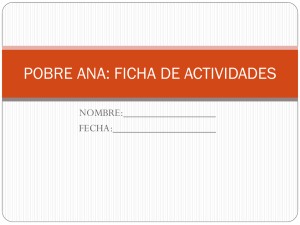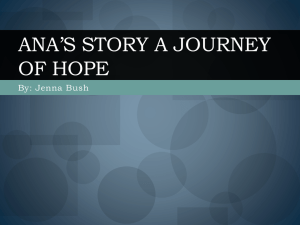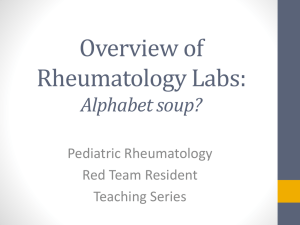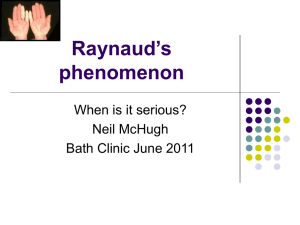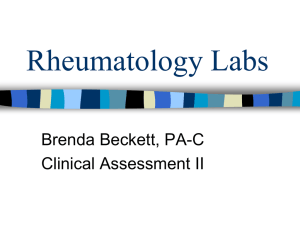Rheumatology Pearls for Primary Care
advertisement
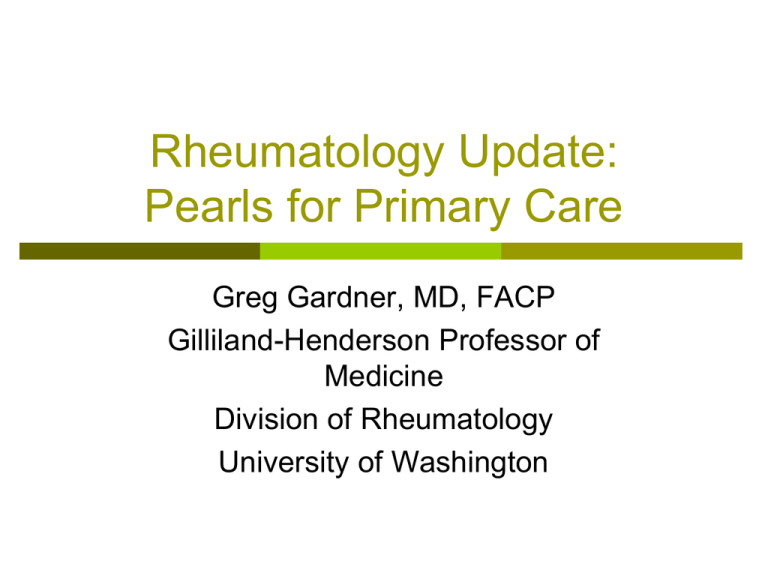
Rheumatology Update: Pearls for Primary Care Greg Gardner, MD, FACP Gilliland-Henderson Professor of Medicine Division of Rheumatology University of Washington Rheumatology Pearl #1 There are only 3 patterns to joint pain: Inflammatory Mechanical (non-inflammatory) Fibromyalgia Inflammatory Mechanical AM stiffness > 30 min (often several hrs) Improvement with activity Swelling common Rheumatoid arthritis, polymyalgia rheumatica 10-15 minutes of AM stiffness Pain worse with use Osteoarthritis, tendonitis Fibromyalgia AM stiffness significant Poor sleep quality Afternoon pain and fatigue Exercise intolerance i.e. feeling “wiped out” Patient History A 45 y/o woman with a 5 year history of rheumatoid arthritis reports 2 hrs of AM stiffness, pain with activity especially in the left knee, and if she overdoes it she can have diffuse joint pain for a day or two after. Reports poor quality sleep. Meds: Methotrexate 15 mg po/wk, etanercept 50 mg sc/wk Exam: No swelling of the small joints of the hands or feet. Small effusion in the left knee. She has multiple tender points of fibromyalgia. Testing: X-ray diffuse loss of cartilage in the left knee; CBC normal, CRP normal WHICH PATTERNS? Rheumatology Pearl #2 Occam Razor vs Hickman’s Dictum William of Ockam Entia non sunt multiplicanda praeter neccessitatem Entities should not be multiplied beyond necessity i.e. the simplest explanation is usually correct John Hickam, MD The patient can have as many diseases as they D_ _ _ well please Pearl 3: Do I Really Want to Check an ANA? 44 y/o woman complains of 10 years of aches and pains and fatigue. Her local care provider checked an ANA and found it was 1:80 and told her she had lupus and referred her to you. She complains of several hours of morning stiffness and any continuous level of activity causes increased diffuse pain. She quit her job as an electronics assembler due to her symptoms. Examination is positive for diffuse tender points otherwise negative. There is no rash, joint swelling, weakness (Pt gives way with strength testing) She wants to know what you are going to do about ANA Pearls: The Pearl of Checking an ANA The sensitivity and specificity of the ANA test along with the rarity of CTDs like SLE mean that most positive ANAs are really false positives! Current gold standard, according to the ACR, is to do ANA screen by IFA and give a pattern and titer and follow with a panel of extractable nuclear antigens Many labs will now only do multiplex method and skip IFA; ANA is positive if ANY of the autoantibodies are detected Multiplex method alone is less sensitive than ANA by IFA and also less specific so higher false positive and negative rates Patterns of ANA by Indirect Immunofluorescence (IFA) Five basic ANA patterns representing antibodies to specific groups of nuclear antigens by IFA: • Homogeneous (SLE) • Speckled (non-specific) • Peripheral (SLE) • Centromere (CREST) • Nucleolar (SLE/Scleroderma) Homogeneous FANA Pattern Screening for Antinuclear Antibodies by Indirect Immunoflorescence Technique (IFA) Step 1: Ab Y Nucleus Patient serum containing ANAs placed on slide containing HEp-2 cells. ANAs attach to cell nucleus Anti-human IgG Slide Y Fluorescein Tag Y Step 2: The preparation is washed and fluorescent labelled antiimmunoglobulinis added. Preparation glows when viewed under fluorescence microscope Extractable Nuclear Antigens (ENA) Dectected by Various Methods Antigen Abbreviation Sjogren’s syndrome A (aka Ro) SSA (SLE/SS) Sjogren’s syndrome B (aka La) SSB (SS/SLE) Double stranded DNA DsDNA (SLE) Smith antigen Sm (SLE) Ribonuclear protein RNP (SLE/MCTD) Scleroderma 70 SCL 70 Chromatin (SLE) Centromere AB nuclear antigens (CREST) Saline extractable are targets of ANAs that help characterize specific illnesses Multiplexed Method for Detecting Autoantibodies 1. 2. 3. 4. 5. 1. Autoantigen is fused to colored micropheres Pt serum is then incubated with microspheres; if autoantibodies are present these will attach to the autoantigen/sphere complex Antihuman IgG/fluorochrome tag then added Microsphere then placed in flow cytometry column that uses two lasers, one to detect color of sphere and one to identify the presence of the antibody/fluorochrome complex Results reported as a number not titer DsDNA 2. Spheres/Antigen + Pt’s serum 3. Fluorochrome tagged antihuman IgG SSA RNP 4. Important Points for Primary Care Always order a reflexive panel ANA particularly useful for Dx of 4 CTDs Negative ANA and negative SSA essentially rules out SLE (sensitivity of doing both is 99% for Dx of SLE) SLE Scleroderma (Diffuse/CREST) Sjogren’s syndrome Mixed connective tissue disease Rare Pt with mild SLE or Sjogren’s will be SSA only + A low titer ANA ie 1:40 or 1:80 is generally clinically irrelevant as is an isolated low level result by multiplex assay 20-30% Nl blood donors have ANA at 1:40; 12% > 1:80 Important Points for Primary Care ANA 1:160 or greater accompanied by other disease characterizing antibodies means disease is present or will be present SLE Pts can have SLE antibodies present prior to the onset of clinical manifestations (mean 3.3 yrs range up to 9 yrs) Specific ENA help characterize disease Pts with high titer ANA plus other autoantibodies should be referred to rheumatology (other clues to CTD?) Other autoimmune diseases can be associated with a positive ANA i.e. autoimmune thyroid diseases, PBC, autoimmune hepatitis, RA Other ANA Pearls Anti-DsDNA & anti-Sm (Smith) are generally specific for SLE Anti-DsDNA goes up and down with disease activity Referral to a community rheumatologist with + ANA and no Dx – up to 50% will have a CTD Dx (approx 20% SLE), and 10% may have autoimmune thyroid disease Pts with isolated + ANA and no disease: 5.6% will come to a Dx of CTD in 5 yrs (data reassuring) Remember that the ANA has to make sense Check an ANA when clinical symptoms and signs point to possible CTD Myckatyn J Rheum 2003;30:736 ANA Profiles Patient 1 ANA 1:640 speckled SSA >100 SSB 30 DSDNA neg Sm neg RNP neg RF 150 Sjogrens Patient 2 ANA 1:320 homogeneous SSA >100 SSB neg DSDNA 632 Sm neg RNP 66 RF neg SLE ANA Profiles Patient 3 Patient 4 ANA 1:320 speckled SSA neg ANA 1:320 Nucleolar SSA neg SSB SSB DSDNA neg neg Sm RNP neg neg SCL 70 >100 neg DSDNA Sm RNP neg neg > 100 RF 35 Mixed Connective Tissue Disease Diffuse Scleroderma ANA Profiles Patient 5 ANA 1:160 speckled SSA neg SSB neg DSDNA neg Patient 6 ANA 1:40 speckled SSA neg SSB neg DSDNA neg Sm RNP RF Sm RNP RF neg neg neg ANA in isolation neg neg neg Clinically insignificant ANA References for ANA Waits JB. Rational use of laboratory testing in the initial evaluation of soft tissue and joint complaints Prim Care Clin Office Pract 2010;37:673–689 Arbuckle MR et al. Development of autoantibodies before the clinical onset of systemic lupus erythematosus. NEJM 2003;349:1526-1533 Shel WC, Jason M. The diagnostic associations of patients with antinuclear antibodies referred to a community rheumatologist. J Rheumatol 1989;16:782-785 American College of Rheumatology Position Paper on ANA testing www.rheumatology.org Pearl 3# Cold Hands or Raynaud’s Phenomenon? A 55 y/o woman complains of 6 months of her hands being very uncomfortable in the cold. Notes that her fingers of both hands turn white when in cold. No report of skin changes in her fingers, joint swelling, difficulty swallowing, DOE, nor family history of Raynaud’s Her general examination is normal How would you evaluate this patient? Step 1: Is it Raynaud’s Phenomenon? Maurice Raynaud first described the manifestation that bears his name in 1862 Vasospasm involving the digits, ears, nose with cold exposure OR emotional distress Populations based survey: 12% report RP Three phases: Pallor related to initial vasoconstriction Cyanosis due to severe flow restriction Erythema due to rebound vasodilitation Cold emersion test available when uncertain Step 2: Is it Primary or Secondary Raynaud’s Primary Raynaud’s Criteria Vasospastic attacks precipitated by cold or emotion Symmetric attacks involving both hands Absence of tissue necrosis or gangrene No examination findings of secondary Raynaud’s Normal nail-fold capillary exam Normal ESR Negative serologic findings in particular ANA Median age of onset 14 yrs old; 27% onset after 40 yrs old 2 yrs of PRP w/o manifestations of CTD; unlikely to be SRP Secondary Raynaud’s Phenomenon Features that suggest secondary Raynaud’s: RP after age > 30 yrs Severe episodes that lead to ischemia Nail fold capillary abnormalities Positive ANA/disease-related antibodies Clinical features of the below diseases Diseases to consider: Scleroderma specturm disease Mixed connective tissue disease Systemic lupus erythematosus Dermatomyositis Polymyositis Features of Secondary Raynaud’s ANA features suggesting CTD High titer ANA Nucleolar pattern Centromere pattern High titer RNP Elevated DsDNA Nailfold Capillaroscopy Normal Dilatation Dropout Dilatation Bizarre Loops Can also use ophthalmoscope Step 3: Evaluation for Secondary Raynaud’s Careful history and exam Medications & RP Nail fold exam (has the highest positive predictive value) Laboratory studies CBC, ESR TSH ANA reflexive panel Consider SPEP, cryoglobulins, CPK Interferon, estrogen nicotine, tobacco, narcotics, cyclosporine, cocaine, ergotamines, clonidine, B blockers sympathomimetics Environment & RP Previous frostbite, repetitive vibration exposure, hypothenar hammer syndrome Step 4: Treatment of Raynaud’s Phenomenon Mild PRP only may require exposure intervention Avoidance behavior Central warmth Windblock gloves Good handwarmers Crazy thermabands Nicotine Caffeine Meds that worsen Biofeedback? Medications Ca channel blockers Not verapamil Losartan Prazosin Topical NTG SSRIs LD ASA with Ca blockers 2 g/day of α-linoleic acid Take home primary care pearls Primary Raynaud’s is common Secondary disease is rare but common enough that with recent onset Raynaud’s, CTD should be considered Unilateral Raynaud’s requires vascular evaluation Treatment should begin with physical measures and avoidance of medications that can make disease worse Referral for: Evaluation suggests secondary Raynaud’s Severe disease not responsive to usual therapy Acute digit threatening ischemia Raynaud’s References Wigley F. Raynaud’s Phenomenon. N Engl J Med 2002;347:1001-1008 LeRoy EC, Medsger TA Jr. Raynaud’s phenomenon: a proposal for classification. Clin Exp Rheumatol 1992;10:485-8. M. García-Carrasco et al. Treatment of Raynaud’s Phenomenon. Autoimmunity Reviews 2008;8:62– 68 Pearl 5: Hyperuricemia: More than Just Gout A 55 y/o male with a history of hypertension, type 2 DM, and CRI develops an acute left 1st MTP pain. Pain is so severe that he is unable to walk on it and even the bed sheets are painful. In the ED noted to have a red painful left 1st MTP and resists you trying to move the joint. Laboratory tests show a normal CBC, creatinine is 1.9 mg/dl, uric acid is “normal” at 7.5 mg/dl, CRP is elevated at 20 mg/L DDx? Treasure Chest of Gout Pearls Most common form of inflammatory arthritis in men over 40; > 5 million affected; rare in women pre-menopause A serum uric acid above 6.8 mg/dl is abnormal even if your lab says 8.5 mg/dl is normal! Uric acid level may go down to normal during attack Certain groups i.e. Pacific Islanders have genetic predisposition to gout Very rarely other diseases produce podraga Small joints of the hands and feet are RARELY septic unless directly invaded Do I really need to aspirate that 1st MTP?? Acute Urate Gout Interval Hyperuricemia Tophaceous Gout Step 1: Treat the Acute Attack NSAIDs Oral Steroids Need 30-40 mg with 5-10 day taper to affect inflammation IM/IA steroids Colchicine Potent short acting agent ie indomethocin Start within 24 hrs; 1.2 mg followed 1hr by 0.6 mg – done Anakinra IL-1 inhibitor works like miracle for complex hospitalized patients who can’t take standard What causes the tiny crystals to cause so much pain? Answer: the innate immune system Uric acid supersaturates, crystallizes and is recognized by inflammatory cells via Toll-like receptors Inflammatory mediators, in particular IL-1, produced and lead to rubor, calor, dolor Step 2: Modify Risk Factors 1. Avoid certain • • medications 2. Medications to avoid • • Avoid beer/ale • 3. • Encourage slow wt loss • 4. Discuss a low purine diet and one low in fructose Diuretics Niacin Calcinurin inhibitors LD ASA Laxatives in excess “Medications” that help • • • • Vitamin C Losartan Statins Dairy products Step 3: Decisions Regarding Hypouricemic Therapy Reasons to consider hypouricemic therapy Hypouricemic agents > 2 attacks/year, tophi, kidney stones, chronic persistent gout CKD, CAD?? Allopurinol - 100-800 mg/d; rash, hypersensitivity syndrome; reduce dose of azathioprine to 1/4 Febuxistat - 40-80 mg/d; liver toxicity, azathioprine issue Probenecid - 250-1000 mg BID; use with meals and hydration; decrease elimination of meds ie PCN Lowering uric acid INCREASES risk of gouty attack Use colchicine prophylaxis where possible 0.6-1.2 mg/day If unable to use provide Pt with as need use predisone, 2012 ACR Guidelines for the Treatment of Gout 1. 2. 3. 4. 5. 6. 7. Educate patient on diet, lifestyle, and treatment objectives Xanthine oxidase inhibitors are first line therapy Treat to target ie < 6 mg/dl (< 5 if tophi present) Starting dose of allopurinol should e no greater that 100 mg/day and less than 100 mg/day in Pts with CKD; slow upward titration that could exceed 300 mg/day even in CKD Screen for HLA B5801allele in Koreans with CKD and all Pts of Thai and Han Chinese descent BEFORE starting allopurinol due to risk of severe hypersensitivity Can combine uricosuric agent with XOI (Pegloticase (pegolated uricase) can be used in severe 1984 Hande guidelines for renal dosing of allopurinol based on concern for drug hypersensitivity not renal toxicity Creatinine Clearance Allopurinol Dosing 0 ml/min 100 mg/3 days 10 ml/min 100 mg/2 days 20 ml/min 100 mg/day 40 ml/min 150 mg/day 60 ml/min 200 mg/day 80 ml/min 250 mg/day >100 ml/min 300 mg/day Severe hypersensitivity reactions are not dose dependent; may not correlate with oxypurinol levels. Puig. J. Rheumatol 16:842-844, 1989 No increase in allopurinol SE in pts receiving higher than Hande recommended doses. VazquezMellado. Ann Rheum Dis 60:981-983, 2001 Following Hande guidelines led to suboptimal control of hyperuricemia & did not prevent hypersensitivity Dalbeth. J Rheumatol 2006;33: 1646-1650 Gardner’s guideline: Go low go slow and treat to SUA level Gouty Tophi Bad Tophaceous Gout Tophi + Allopurinol + Patience = Success Summary of Some of the Recent Information on Uric Acid and Inflammation Xanthine Oxidase is a superoxide producing enzyme; allopurinol inhibits XO and thus has antioxidant properties by preventing generation of free radicals Filiopoulos et al Renal Failure 2012 Hyperuricemia and CKD/CAD Emerging literature on the role of hyperuricemia and progression in CKD Control of hyperuricemia can improve BP Control of hyperuricemia slows/halts progression of CKD Uric acid level is an independent risk factor for all cause mortality in men and women with a known history of CAD as well as an independent risk factor for CHF Hyperuricemia affect may be more pronounced in African Americans Outcome of BP/Creatinine at 12 mo using allopurinol to normalize hyperuricemia in Pts with CKD Siu et al. Am J Kidney Dis 2006;47:51-59 54 pts randomized and followed for 12 months. Initial UA in Rx group 9.75 & trial end 5.88; control group 9.92 vs 10.08 84% Rx group stable renal function vs 53% control group Hyperuricemia and Mortality 2013 1054 Pts with known CAD followed > 3 yrs and all cause mortality evaluated by quartiles of UA 79% male Mean age 65 yrs Unadjusted and adjusted mortality evaluated Lin et al. J Cardiology 2013 Take Home Points More reasons for gouty Pts to lower uric acid level than just gout Role of xanthine oxidase inhibitors and CKD/CAD to be further elucidated Not quite ready to lower UA primarily to address CKD/CVD but certainly do for pts with gout Old thinking about simply treating gouty attacks until tophi appear then instituting hypouricemic therapy is out of date and not in Pts best interest References for Hyperuricemia and Gout Terkeltaub R. Update on gout: new therapeutic strategies and options. Nat Rev Rheumatol 2010;6:30-38 Filiopoulos V, et al. New insights into Uric acid effects on the progression and prognosis of chronic kidney disease. Renal Failure 2012;34:510-520. Bhole V Krishnan E. Gout and the heart. Rheum Dis Clin NA 2014;40:125-143.

